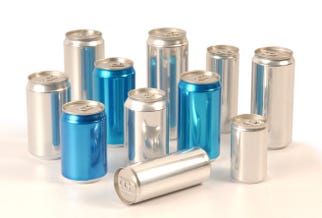Tips for switching craft beers to cans
January 30, 2014

Crown cans for craft brewers
Sales in the craft brewing industry are on the rise. According to the latest statistics from the Brewers Assn., 2010 saw an industry growth of some 11 percent over 2009, and the trend looks set to continue. With more than 1,700 craft breweries across the United States, it is unsurprising that a growing number of brewers are experimenting with alternative packaging formats to differentiate and enhance the quality of their beers. In particular, metal is increasing in popularity as the industry learns more about the benefits that the format offers.
For brewers unaccustomed to packaging their craft brews in metal, the prospect of using a new material can be daunting, but this need not be the case. Recently, Crown Beverage Packaging North America's Tom Hughes, marketing manager, and Andy Navarro, director of customer technical services, sat down for an informal discussion about how brewers can successfully introduce metal into their packaging portfolios.

Tom Hughes at Crown
Q: Why do you think so many craft brewers are turning to metal?
Hughes: There are number of reasons, I think. Metal packaging is valued for its portability—it is durable enough to keep up with consumers' active lifestyles, without any concern of accidental breakage. Metal is also sustainable—it is 100 percent and infinitely recyclable, making it a strong packaging choice for environmentally-conscious shoppers.
Navarro: But perhaps what is most important, at least to consumers, are the benefits it brings to the quality of the beer. A metal package keeps the drink fresh; it blocks sunlight, preventing the beer from spoiling; and metal cools more rapidly than other packaging materials, so you get to enjoy your drink sooner.
Q: What's the first thing a brewer who's new to metal should consider?
Hughes: Well, I think it's fair to say that transitioning to any new material or format entails more than just working with a new supplier. You have to consider the kinds of changes that need to be made to your existing packaging lines and processes. Those changes don't necessarily have to be costly or complex, but the first step should still be to consider how your own packaging processes may change.
Navarro: Absolutely. There is going to be a certain amount of new equipment required for metal packaging. And to reiterate what Tom said, that doesn't mean entry into canning is cost-prohibitive; rather it's an opportunity to consider the future of your business. Wherever possible, look at purchasing expandable equipment that will enable you to grow your product lines quickly and easily, as the market requires.
The types of equipment required will depend on your needs. Machines for packaging and handling the cans themselves are obviously a priority, but don't forget to consider secondary technologies as well. One of the more common issues we see brewers face is sealing. If all of the oxygen is not properly removed from the container it can effect the flavor and even lead to leakage. That's why we always work with our customers to make sure they have the right filling and sealing equipment from the start.
Q: Beyond equipment, what other differences should a brewer expect?
Navarro: Graphics should definitely be considered early on in the process. Craft brews each have their own individual flavors and personalities and these are often reflected in the very distinct and unique imagery and logos on the containers themselves. So, for craft brews perhaps more than any other beverage, the graphics associated with a particular beer can be more important to the brand than the name. You can certainly achieve a level of artwork and imagery quality on metal cans that is similar to that on printed labels, but the decoration process is going to be very different.
Some of the differences are purely practical. For example, cans have a larger surface area than bottles, so designs will need to be reformatted. This added space brings some distinct benefits, as it serves as a billboard of sorts and lets graphics pop more.
At Crown we're aware how important it is to get the graphics right, and we come prepared to work through several iterations if necessary to achieve the final design. It's an important process and one that shouldn't be hurried. For that reason, we go through a complete process with our customers to set up and execute trial print runs for approval before going to press.
Hughes: That's right—it's important to take the time to get it right before you commit. And at the same time, there's a lot to be said for involving your supplier, wherever possible, at the start of the artwork creation. We have a lot of experience in both design and printing, which translates to consistency and accuracy for our customers.
Q: So what sort of partnership should craft brewers have with their suppliers?
Hughes: Definitely hands on! Since you are facing transitioning to a completely new packaging format, it's vital to establish partnerships with suppliers as early on in the process as possible.
Navarro: Right. And be prepared to work step-by-step through the process with your supplier to identify the priorities on each side. That will also be a good opportunity to troubleshoot any potential issues or problems before they arise. That way, the brewer benefits from the supplier's deep knowledge of the material, which improves the quality of the final package and it also ensures that everyone's expectations and schedules are in sync.
It's also important to emphasize the value of face-to-face interaction. Wherever possible, brewers should try to arrange on-site visits to their supplier's operations. In fact any good partner will encourage this, especially at the start of a new business relationship or for the initial run. These visits will help brewers better understand how the supplier's processes and systems work in relationship to their own.
Hughes: Early communication with a supplier will also help avoid any complications down the line. Brewers should talk with their suppliers about order turnaround time, minimum runs and which periods are considered to be the high season. Discussing these details reduces the likelihood of issues or delays once work begins.
Andrew Navarro at Crown
Q: What other attributes should a brewer look for in a supplier?
Navarro: Look for a supplier who offers support on how to achieve the best results with the packaging process. A good partner will understand the importance of getting it right first time and should be prepared to provide an on-site evaluation of a brewer's process and capabilities along with training for any new equipment.
This evaluation benefits all the parties involved—it gives brewers the confidence they need in their new product line and it allows suppliers to identify any potential problems early in the process.
Hughes: The right supplier should also understand that this is an ongoing partnership, not a one-off transaction. They should provide contacts for technical support that brewers can communicate with regularly—not just in an emergency—if any questions or issues come up.
Good technical support is not just about fixing something when it's gone wrong. It's about providing regular guidance on topics that brewers may not be familiar with, such as full can handling, seaming and graphics.
Q: Any final thoughts or advice?
Hughes: For craft brewers considering transitioning to metal packaging, I think the best strategy is to get the advice of a peer who has gone through the same experience. Suppliers should definitely be an additional resource. They can provide strong counsel on the ins and outs of canmaking and provide guidance to make the transition successful and efficient.
Navarro: As Tom said, can suppliers will have a wealth of information to ease the transition process. There are also general resources, including associations, publications and trade shows that focus on the metal packaging industry and can provide supporting information.
Source: Crown Holdings Inc.
.
About the Author(s)
You May Also Like


